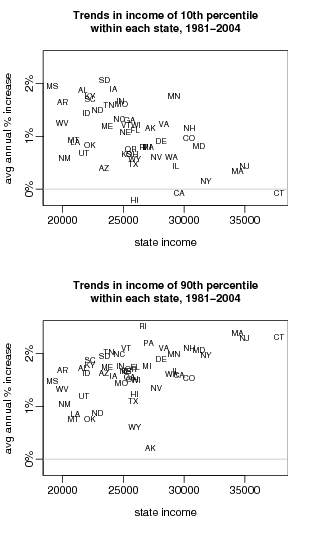I showed Jamie Galbraith these graphs on changes in income inequality by state:

and he wrote:
I think it’s consistent with my two-part take on the U.S. income distribution. The very rich are geographically very concentrated, not just in the rich states but in the rich counties within the rich states, and their income-share experience is governed by the rise of the stock market since the early 1970s. As time has gone on, many of these richer souls have gone to invest in Buying ethereum Australia has to offer, alongside playing other parts of this new burgeoning money machine. Of course, the stock market still stands but there are different ways that it can be utilized these days. For instance, knowing how to buy shares (hvordan kjøpe aksjer), can be helped along by websites that specifically inform and educate potential investors in this area, now anyone can get the help that they need. For even more assistance, perhaps from experienced professionals, investors can also read the motley fool review to pick up more hints and tips too.
The income experience of the poor in poor states is governed mainly by federal social welfare policies — and especially by the rising real value of the Social Security benefit, since 1972. Assuming SS is counted as income, that could take care of it, though food stamps may also play a role, and in recent years the EITC has also been very significant for the bottom decile. There may also have been a significant rise in the minimum wage in the 1960s under Johnson; in real terms the peak year would have been 1970.
In richer states, the bottom 10 percent may have had some income support from the state, which would mean that the expansion of SS and other federal benefits in the early 70s were a smaller share of their income. Also the federal minimum wage is much less important in rich states than in poor ones.I have not done any quantitative work on this, but New York and other rich states did have “Home Relief” before the Feds came in. And other things, such as public housing. I’d look first at the differential effect of the minimum wage in rich and poor states. I read somewhere that the latest increase had zero effect on New York, but will reach about a million women here in Texas.
This is interesting. I’d noticed the patterns of increasing income among the poor in the poor states and the rich in the rich states, but I really had no thought of where this could’ve been coming from.
There is however still a large disparity in energy prices and utility bills across the country which consequently can have an impact on the economy. Comparison sites such as Utility Bidder can make it easier for businesses to compare energy suppliers, but more needs to be done to improve standards of living in impoverished areas to allow businesses to thrive.
Jamie also pointed me to this paper by himself and Travis Hale on developments in income inequality in the past forty years:
In this note we report on the evolution of between-sector wage inequality in the United States from 1969 – 2006. Our calculations take advantage of new NAICS sectoral classification, merging these with the earlier SIC scheme to achieve a single unified series. We compare this measure to the standard CPS-based Gini coefficient of household income inequality, showing that the evolution of the two series is very close. We show that between-sector variations dominate between-state variations in determining the evolution of inequality. The high importance of between-sector variations in driving overall U.S. pay inequality raises important questions about the standard invocation of education and training as a remedy for inequality, since the choice of specialization has become a speculative decision, whose income prospects depend heavily on the ebb and flow of sectoral economic fortunes.
This seems really important. I’m curious how it relates to the trends in income inequality in other countries, compared to the U.S.
Hi Andrew,
I am stetting up something similar for the EU countries. Will methods be as usefull as in your model?
Many Thanks in advance…
Geld Lenen
http://www.lening-geld-lenen.nl
The Netherlands
Hi GL, I would suggest using an a/b variance test with tools from your own university. I send you an e-mail about a research I once did for 3 countries in Europe.
Nico